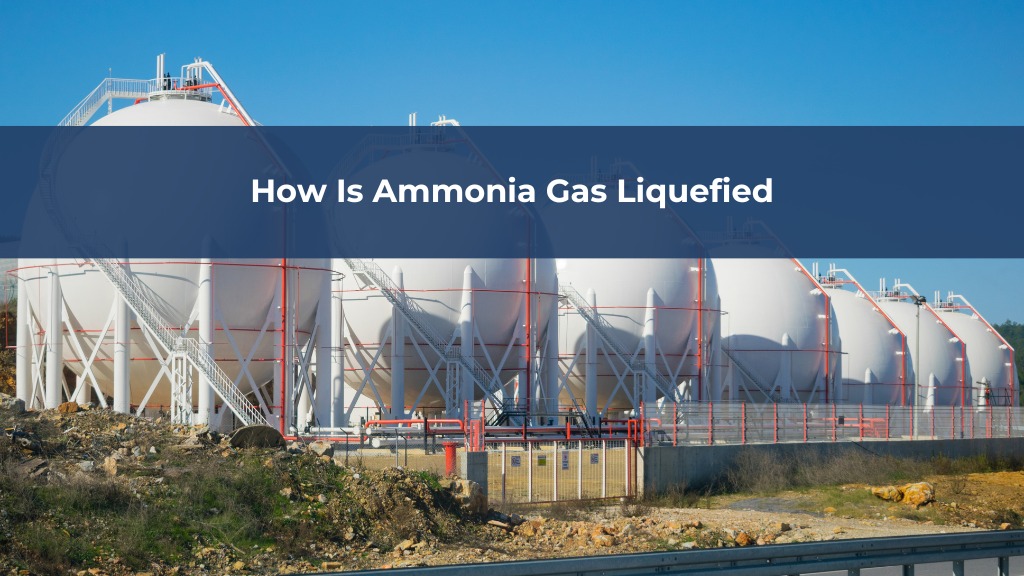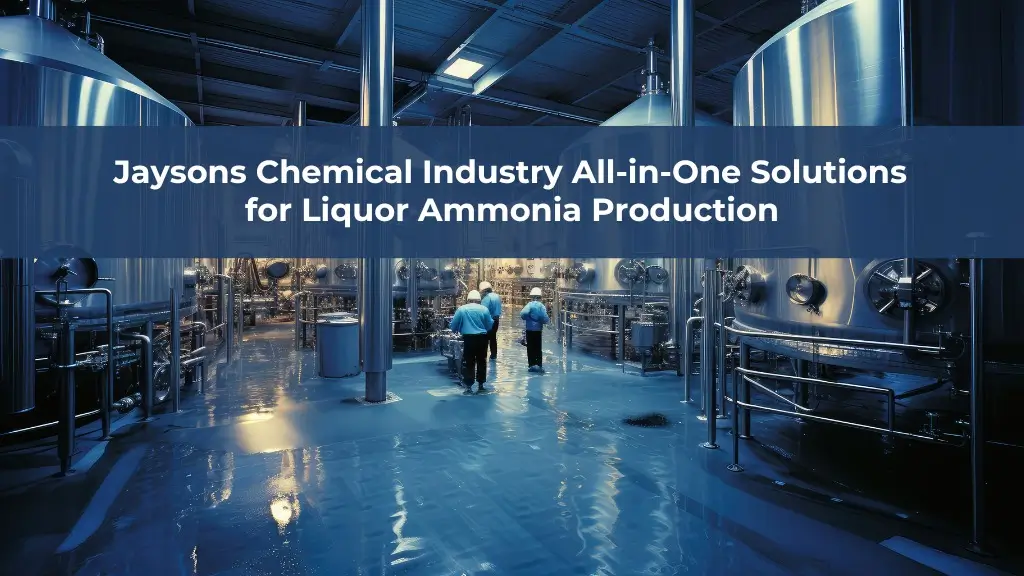Ammonia gas is a commonly used chemical compound that has a wide range of applications. From agriculture to industry, it plays a crucial role in various processes. But have you ever wondered how this gas can be liquefied? In this article, we will explore the fascinating process of ammonia gas liquefaction, as well as its properties, safety measures, applications, and environmental impact.
Understanding the Properties of Ammonia Gas
Before delving into the liquefaction process, let’s take a moment to understand the properties of ammonia gas. Ammonia, scientifically known as NH3, is composed of one nitrogen atom and three hydrogen atoms. It is a colorless gas with a strong and pungent odor, often described as “sharp” or “stinging.”
Aside from its distinct smell, ammonia gas also showcases interesting physical characteristics. It is lighter than air, which means that it will rise in the atmosphere. Additionally, it is highly soluble in water, forming a strong alkaline solution known as ammonium hydroxide.
Ammonia gas has been used for various purposes throughout history. In ancient times, it was commonly used as a cleaning agent due to its ability to dissolve grease and oils. The Egyptians, for instance, used a mixture of ammonia and soap to clean their clothes. This practice continued for centuries, with ammonia-based cleaning products being widely used in households around the world.
Furthermore, ammonia gas plays a crucial role in the production of fertilizers. The Haber-Bosch process, developed in the early 20th century, revolutionized agriculture by enabling the large-scale production of ammonia. This process involves combining nitrogen gas from the air with hydrogen gas derived from natural gas or coal. The resulting ammonia is then used as a key component in the production of nitrogen-based fertilizers, which are essential for crop growth.
The Process of Liquefying Ammonia Gas
Now that we have a basic understanding of ammonia gas, let’s explore the process of liquefying it. Liquefaction refers to the transformation of a gas into a liquid state. In the case of ammonia, this process involves a combination of pressure and temperature control.
The Role of Pressure in Liquefaction
Pressure plays a crucial role in liquefying ammonia gas. By compressing the gas, pressure forces the ammonia molecules closer together, reducing the space between them. As a result, the intermolecular forces intensify, allowing the gas to transition into a liquid state.
Imagine a container filled with ammonia gas. As the pressure inside the container increases, the ammonia molecules start to collide more frequently. These collisions transfer energy between the molecules, causing them to slow down and lose kinetic energy. Eventually, the pressure becomes so high that the ammonia molecules are forced to occupy a smaller volume, leading to liquefaction.
During the liquefaction process, the pressure applied is typically greater than that of the atmospheric pressure. This elevated pressure is necessary to overcome the natural tendency of ammonia to remain in its gaseous form. Without sufficient pressure, the ammonia molecules would continue to move freely and resist condensation into a liquid state.
The Importance of Temperature Control
While pressure is essential, temperature control is equally important in the liquefaction of ammonia gas. Cooling the gas decreases the kinetic energy of the ammonia molecules, causing them to slow down and move closer together.
Within the liquefaction process, there are two main approaches to temperature control: cooling and expansion. By cooling the ammonia gas to temperatures below its boiling point (-28°F or -33°C), it can condense into a liquid. Another method involves expanding the gas rapidly, leading to adiabatic cooling and subsequent liquefaction.
It is fascinating to note that the liquefaction of ammonia gas was first achieved by the Dutch chemist and physicist, Heike Kamerlingh Onnes, in 1908. He used a combination of pressure and cooling techniques to successfully transform ammonia gas into a liquid, marking a significant milestone in the field of cryogenics.
By understanding the intricate interplay between pressure and temperature control, scientists and engineers have been able to develop efficient processes for liquefying ammonia gas. This has opened up a wide range of applications, from refrigeration and air conditioning systems to the production of fertilizers and industrial chemicals.
Safety Measures in Ammonia Gas Liquefaction
Given the hazardous nature of ammonia gas, it is crucial to implement proper safety measures during the liquefaction process. This includes both the use of protective equipment and the establishment of emergency procedures and protocols.
Ammonia gas, with its pungent odor and toxic properties, demands utmost caution and attention to detail. The safety of personnel and the surrounding environment should be the top priority when handling this potentially dangerous substance.
Protective Equipment for Handling Ammonia
When working with liquefied ammonia, it is essential to use appropriate protective equipment. This typically includes gloves, goggles, and respiratory protection to safeguard against potential exposure. The gloves should be made of materials that are resistant to ammonia, such as neoprene or nitrile, to provide an effective barrier. Goggles with airtight seals and respiratory masks equipped with ammonia-specific filters are crucial in preventing any accidental inhalation of the gas.
Furthermore, it is important to ensure that the protective equipment is properly maintained and regularly inspected. Any signs of wear or damage should be addressed immediately to guarantee its effectiveness in providing adequate protection.
Emergency Procedures and Protocols
In the unfortunate event of an ammonia gas leak or release, it is crucial to have well-established emergency procedures and protocols. These protocols should include evacuation plans, communication strategies, and guidelines for handling and containing the leak. It is essential to have designated assembly points and clear instructions on how to alert emergency response teams.
Regular training and drills should also be conducted to ensure that all personnel are familiar with these procedures. These drills not only serve as a refresher for employees but also help identify any potential gaps in the emergency response plan. By simulating different scenarios, employees can practice their roles and responsibilities, ensuring a quick and efficient response in case of an actual emergency.
Moreover, it is important to maintain an open line of communication with local authorities and emergency services. Regular meetings and discussions can help establish a collaborative relationship, ensuring a coordinated response in the event of an ammonia gas incident.
Applications of Liquefied Ammonia Gas
The liquefied form of ammonia gas finds extensive use in various fields. Let’s explore some of its applications in agriculture and industry.
Use of Liquefied Ammonia in Agriculture
In agriculture, liquefied ammonia is commonly used as a fertilizer. Its high nitrogen content makes it an excellent source of nutrients for plants. By applying liquefied ammonia to the soil, farmers can enhance crop growth and yield. It is essential, however, to handle and apply ammonia with caution to prevent adverse effects on the environment and human health.
One interesting aspect of using liquefied ammonia as a fertilizer is its ability to improve soil fertility. When ammonia is applied to the soil, it undergoes a process called nitrification, where it is converted into nitrates. These nitrates serve as a vital source of nitrogen for plants, promoting healthy growth and development. Additionally, the use of liquefied ammonia as a fertilizer can help reduce the need for synthetic nitrogen-based fertilizers, which can have detrimental effects on the environment.
Industrial Uses of Liquefied Ammonia
Beyond agriculture, liquefied ammonia has a wide range of industrial uses. It is commonly employed as a refrigerant in various cooling systems, such as air conditioners and industrial refrigeration units. Furthermore, ammonia is used in the production of numerous chemicals, including fertilizers, cleaning agents, and explosives.
One fascinating application of liquefied ammonia in industry is its role in the production of synthetic fibers. Ammonia is a key component in the manufacturing process of materials such as nylon and rayon. It helps in the creation of strong and durable fibers that are used in a wide range of products, including clothing, carpets, and upholstery. The versatility of liquefied ammonia in industrial applications highlights its importance in various manufacturing sectors.
Environmental Impact of Ammonia Gas Liquefaction
While ammonia gas liquefaction offers several benefits, it is crucial to consider its environmental impact. Emissions and air quality concerns are significant aspects to address.
Emissions and Air Quality Concerns
During the process of ammonia gas liquefaction, emissions of ammonia gas can occur if proper measures are not in place. These emissions contribute to air pollution and may have detrimental effects on both human health and the environment. It is essential to monitor and control these emissions to minimize their impact.
Ammonia gas, when released into the atmosphere, can react with other pollutants and form fine particulate matter, which can be harmful when inhaled. These particles can penetrate deep into the lungs, leading to respiratory issues and exacerbating existing conditions such as asthma. Additionally, ammonia emissions can contribute to the formation of ground-level ozone, a harmful pollutant that can cause respiratory problems and damage crops.
In order to address these air quality concerns, advanced filtration systems can be employed to capture and remove ammonia gas emissions. These systems utilize various techniques, such as absorption or adsorption, to effectively trap the gas before it is released into the atmosphere. By implementing these filtration systems, the amount of ammonia gas emitted can be significantly reduced, thus minimizing the impact on air quality.
Mitigation Strategies for Environmental Impact
To further mitigate the environmental impact of ammonia gas liquefaction, various strategies can be implemented. These may include the use of renewable energy sources for the liquefaction process, reducing the carbon footprint associated with the production of ammonia. By utilizing solar or wind energy, for example, the reliance on fossil fuels can be minimized, leading to a more sustainable and environmentally friendly process.
Furthermore, stringent regulations and standards can be put in place to ensure responsible handling and disposal of ammonia. These regulations can include guidelines for storage, transportation, and proper disposal methods to prevent accidental releases and minimize the potential for environmental contamination. By adhering to these regulations, the risk of environmental damage can be significantly reduced.
In conclusion, while ammonia gas liquefaction offers numerous applications in agriculture and industry, it is vital to implement proper safety measures and consider the environmental impact associated with its production and use. By monitoring and controlling emissions, utilizing advanced filtration systems, and implementing renewable energy sources, we can ensure the responsible handling and utilization of this versatile chemical compound. Through these efforts, we can minimize the environmental impact and contribute to a more sustainable future.













